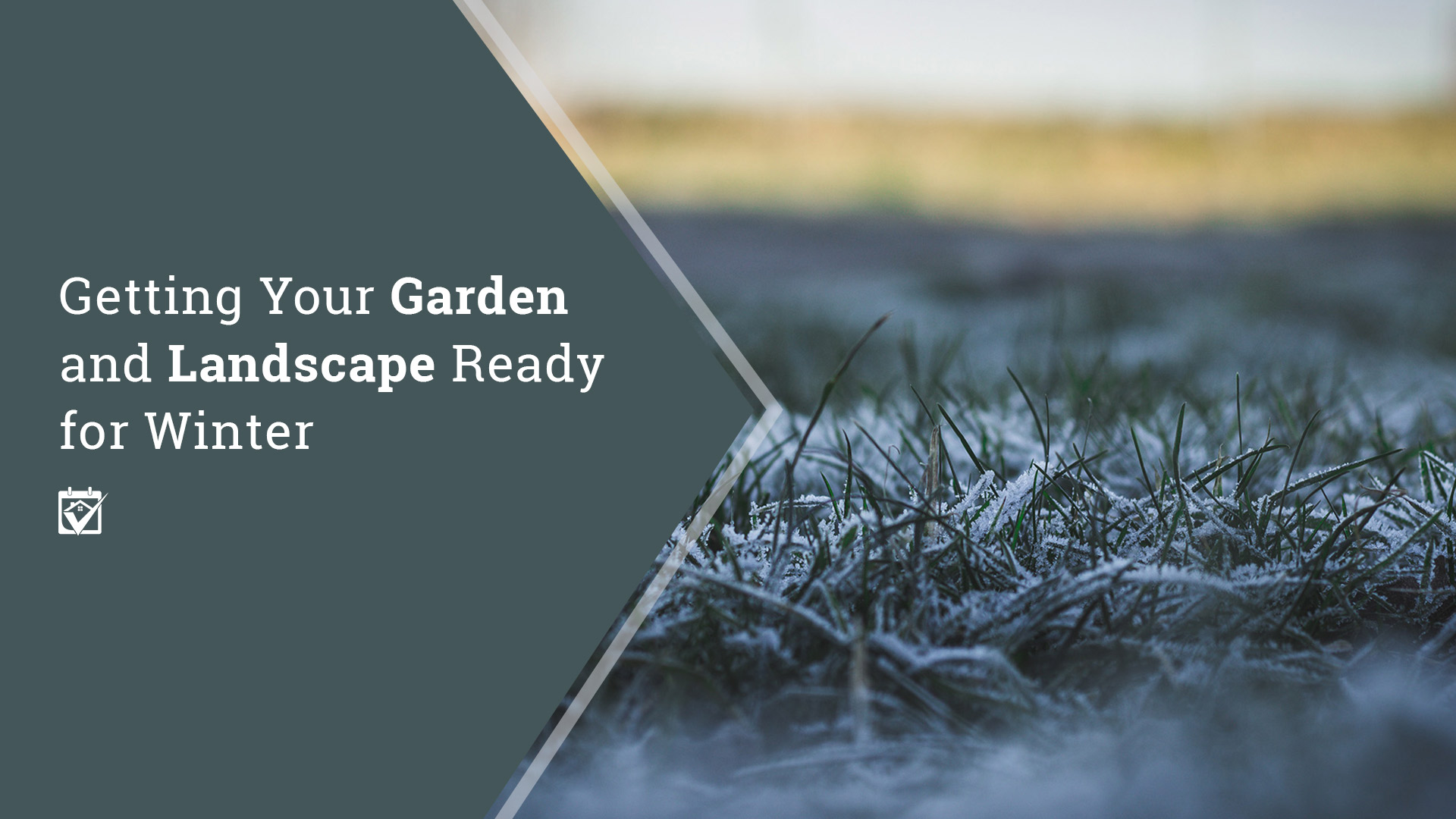There’s nothing quite as solemn as watching the garden and landscape start to wind down for a long winter’s rest. It’s part of the never-ending cycle of nature — and landscaping chores — that you’ll find yourself participating in as a homeowner. Shed a small tear for the beauty of the cycle, then head out to the garage because you’ve got a lot of work to do to get your garden and landscape ready for winter.
Ready? Here we go!
Begin at the Beginning
Every landscape and garden is different, but it can be generally agreed upon that your landscape consists of some kind of turf (grass), some shrubs or small trees, maybe a large tree, annuals, perennials, bulbs, a garden spot and potted plants. Give or take. All of these guys are competing with you for attention as fall turns to winter — they’re screaming your name, in fact. But you can’t tend them all at the same time, which is why you need to make a plan of attack before you ever start.
Things that absolutely have to be done before it frosts for the first time include:
Bringing tender potted plants indoors.
Covering tender outdoor plants.
Mulching everything you’d like to see next year.
Saying good-bye to the rest.
You can wait until there’s a freeze warning in effect to handle chores like:
Digging bulbs.
Turning over the vegetable garden.
Trimming away dead material from trees and shrubs.
Mowing the grass one last time.
Although we’d never advocate that you wait until the last minute to do any of these chores, we also know you’re probably pretty busy, so it makes more sense to let you know what the deadlines really are. With this information in hand, you can start planning your attack.
Mulching 101
One of the most important things you’ll do when you’re putting your landscape to bed is applying mulch to it. “How hard can this be?” I can hear you through the computer screen. It’s not hard, but it is specific, which means it deserves an explanation so you’ll do it right. So here we go.
There are lots of different kinds of mulch out there, anything from bark to pine needles and shredded bits of wood and even those rubbery bits that used to be tires. Basically anything that can hold on to moisture and isn’t a rock will work. Largely, it’s an aesthetic choice, but do keep in mind that as your mulch breaks down, it will contribute to the soil composition. So if you need to increase the acidity, choose more acidic materials, and so forth.
It’s not so much what you apply, but how you apply it. When you lay down winter mulch, it should be in a thick layer, two to four inches deep. Get a tape measure because this can literally mean life or death for your plants. Don’t let the mulch touch the plant, not anywhere. Instead, make your mulch into a sort of tube cake around the base of your plant, where the plant is in the hole. Piling mulch up against the trunk can encourage disease and that’s not a thing you want. Space it one to two inches off the plant, just enough that no mulch touches any part of the plant.
See, it wasn’t hard. Just specific. If you have bulbs that you’re leaving in place for the winter (plenty will survive this way), make sure to mow down any dead plant matter, then mulch them just as deeply, but instead cover the whole plant. This will ensure it survives the winter, protected from the cold.
Bright Ideas for Bulbs and Plant Divisions
For some reason, people are often incredibly intimidated by the idea of digging up bulbs and dividing plants in the fall. This is a no big deal situation, much like the mulching. You just need to learn how to do it right.
When you dig up bulbs, the one thing to keep in mind is that they should be kept in conditions that allow them to be just moist, never wet, and certainly not bone dry. Most experienced gardeners will keep uprooted bulbs in pots of damp sand in a dark corner of the garage. This way they’re still cool and won’t get confused about the season, but they’re protected from frost. Water when the sand feels dry. And whatever you do, don’t leave them in standing water!
As for dividing plants, it’s actually kind of a similar thing. The trick is to keep them moist. If you’re going to move the newly divided plants to another area in your landscape, prep that first. Have it totally ready and watered and everything. Then you can just run them over and they won’t have a chance to dry out. When you divide them, there’s no hard and fast rule about how to do it. You just break the plants in half or quarters or whatever suits you, then quickly replant the pieces. It’s really that easy.
Not everything can be divided like this, but the plants that can are really obnoxiously good at surviving despite what you may do to them. Examples include iris, peony, hosta, shasta daisy — basically any perennial with a clumping root ball, rhizomes or bulbs.
Turning Over a New Leaf in the Garden
Now we’ve come to the vegetable garden, or maybe yours is an herb garden, or some combination. It’s a place you need to take special care because you’re likely to eat something out of it and we want to make sure it’s all it can be. Fall or early winter is the very best time to get your garden spot ready for spring.
It sounds like overkill, but when you’re working with organic matter, you have to consider that it takes some time for all of that stuff to break down. Compost, on average, needs about three months to become helpful. If you wait until April to incorporate your organic stuff, it’s not going to really be available to your plants until half way through the growing season. That’s just not an efficient use of your energy.
Instead, let’s do it now and have everything ready to go in April instead!
First of all, you’re going to need a soil test. Do that before you do anything else. This will help inform what you incorporate. If your garden’s short on nitrogen, for example, you can take care of that at the same time you work your compost in. Compost alone likely won’t contain enough nitrogen to cure a deficiency, but it will improve the quality of the soil itself, making it less likely to compact, help it hold on to just the right amount of moisture and drain away the excess. It’s pretty amazing stuff for something that’s essentially garbage.
When you’re working with compost, remember that you don’t want to work in more than what would be equivalent to 25 percent of the depth of your garden spot. So, if you generally till down to 10 inches, don’t put in more than 2.5 inches of compost this year. Easy peasy.
If your soil test shows you’ve got other issues, you should consult with your local university extension office for advice. There are a lot of local variables involved that would make this blog a novel if I went into it all. They can recommend an organic or traditional treatment to work in along with the compost. Kill two birds with one stone that way. Wait the full three months to recheck your soil, then adjust again if necessary.
You may have heard of something called a green manure that some gardeners use in their plots. These are generally legumes like clovers or soybeans that are used to help improve the soil and help hold it in place. If you want to try one, it’s very important that you choose a legume because they can actually increase nitrogen levels in the soil instead of depleting them. Just till the plants under before they bloom and you’re golden.
Saying Goodnight Doesn’t Mean Saying Goodbye
You’ve mulched your daylilies, you’ve pulled up your dahlias, your daisies are divided and you’ve prepped your garden spot for next year. It seems like you’re ready to take a well-deserved winter’s break. Next spring, your plants will be back, bigger and stronger than ever before thanks to your dedication and care.
If you’re not sure that you’re up to the task this year, or you just need an extra hand with some of the garden chores, take a look at the gardeners and landscape experts available through HomeKeepr. Our recommended experts have years of experience working with all kinds of plants in your area and can show you exactly how to properly put every member of your landscape to bed for the winter.



